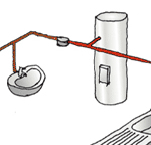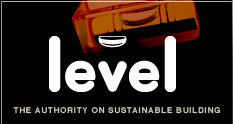Water
Water use, sustainability, and efficiency by choosing quality systems and materials, and providing environmentally friendly solutions.
Hot water supply
Hot water supply must be adequate to meet building users’ needs while also keeping them safe. It should also support efficient use of both energy and water.
On this page:
- Code requirements
- Controlling temperature
- Controlling pressure
- Water heating options
- Other considerations
In designing a water heating system, the key decisions will include the source of energy for water heating, whether to use a storage cylinder or continuous flow system, system layout, and system capacity (including delivery rate, recovery rate, actual and potential number of users, type and number of fixtures within a household).
The system must be designed to meet safety requirements, which largely concern controlling temperature and pressure to ensure there is minimal risk of scalding or of a storage cylinder exploding.
A well-designed system will also minimise energy and water use, for example by using an efficient heating source, ensuring the pipe runs are relatively short, and by using efficient fixtures and appliances.
Code requirements
The NZ Building Code clause G12 Water supplies requires hot water systems to meet a number of objectives including to:
- provide potable hot water to outlets for consumption, food preparation, utensil washing and oral hygiene
- prevent growth of Legionella bacteria, which can cause serious health problems
- protect users from scalding during personal hygiene activities
- be safe from explosion
- be efficient and avoid energy wastage.
NZS 4305:1996 Energy efficiency – domestic type hot water systems sets the energy efficiency requirements for hot water storage cylinders including:
- maximum standing heat loss (kWh per day) for electric hot water cylinders of different sizes
- maximum gas consumption rate and minimum thermal efficiency for gas hot water cylinders.
There are also mandatory New Zealand Minimum Energy Performance Standards (MEPS) under Building Code Acceptable Solution H1/AS1. EECA has published a list of electric storage water heaters that comply with these.
Controlling temperature
Water heated to more than 50°C can cause serious burns in less than a minute. This creates risk, particularly for children (who have sensitive skin) and the elderly (who have slower reaction times).
Under Acceptable Solution G12/AS1, in household units hot water delivered to sanitary fixtures used for personal hygiene such as basins, baths and showers should not exceed 50°C. Lower temperatures are required for some buildings such as hospitals, schools, and care facilities.
The maximum was reduced from 55°C to 50°C when G12/AS1 was amended in November 2023, with a 12-month transition period that ends in November 2024.
Hot water may be delivered to domestic kitchen sinks and laundries at higher temperatures – generally around 55°C to 65°C.
If a storage cylinder is used, the water must be heated to over 60°C at least once a day to prevent the growth of Legionella bacteria. The water must then be tempered to reduce the temperature before it is delivered to outlets. See storage cylinders for more detail.
Continuous flow systems are not at risk as they do not store water that would allow growth to occur.
Controlling pressure
In buildings with mains pressure water supply, a system of valves and controls will be required to regulate water pressure and temperature. Many manufacturers and importers of plumbing valves, tapware and appliances require 500kPa pressure maximums for warranty purposes, with the limiting valves protected by line strainers. See Controlling pressure in storage cylinders and Valves and controls for more detail.
Water heating options
Probably the key decisions to be made are which energy source to use, and whether to use a storage system or a continuous flow one.
In continuous flow systems, water can be heated using electricity or gas. In storage systems, the water can be heated using electricity, gas, solar energy or a wetback.
Each energy source has its advantages and disadvantages, as do storage and continuous supply systems. In general, solar, solar photovoltaic, heat pump and wetback systems are more energy efficient than traditional electric and gas systems. Continuous flow systems can be efficiently used in some circumstances, such as to boost a solar system, or to feed an outlet that is some distance from the main hot water supply.
See water heating in the energy section of this site for more detail on these options.
The government’s Gen Less website has online resources to help homeowners and their advisors select a water heating system.
Operational carbon must also be a consideration today – what systems contribute to a house with a lower carbon footprint. In its advice to Government released in June 2021, the Climate Change Commission recommended that New Zealand phase down use of fossil gas (natural gas) in existing residential, commercial and public buildings and avoid the addition of new fossil gas demand (i.e. by not installing new connections to buildings). Heat pump water heaters are widely recommended as a good option in a low-carbon house with moderate to high hot water use.
Other considerations
As well as specifying an efficient energy source, water and energy efficiency can be enhanced by:
- designing the system to minimise pipe runs – for example, by locating the storage cylinder close to the kitchen, laundry and bathroom
- specifying low-flow fixtures
- specifying appliances that use water and energy efficiently
- for a remote outlet, especially one that is not used every day, install a continuous-flow hot water system so that hot water does not need to be stored
- insulating the pipes to reduce heating costs (but this has less impact than reducing pipe lengths)

- Avoiding waste through long hot water pipe runs
If a kitchen is remote from the hot water storage system, install a secondary continuous-flow system to reduce water wastage.
Updated: 02 November 2023

